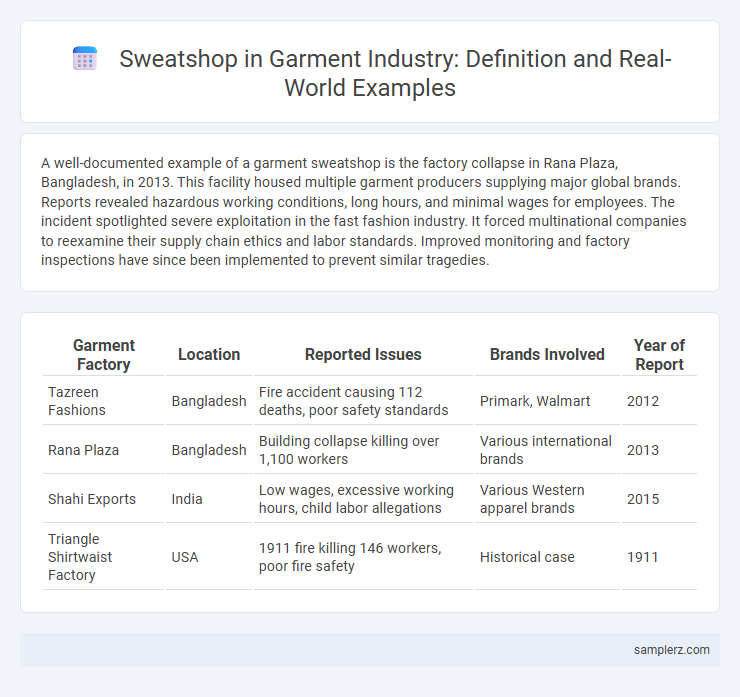A well-documented example of a garment sweatshop is the factory collapse in Rana Plaza, Bangladesh, in 2013. This facility housed multiple garment producers supplying major global brands. Reports revealed hazardous working conditions, long hours, and minimal wages for employees. The incident spotlighted severe exploitation in the fast fashion industry. It forced multinational companies to reexamine their supply chain ethics and labor standards. Improved monitoring and factory inspections have since been implemented to prevent similar tragedies.
Table of Comparison
| Garment Factory | Location | Reported Issues | Brands Involved | Year of Report |
|---|---|---|---|---|
| Tazreen Fashions | Bangladesh | Fire accident causing 112 deaths, poor safety standards | Primark, Walmart | 2012 |
| Rana Plaza | Bangladesh | Building collapse killing over 1,100 workers | Various international brands | 2013 |
| Shahi Exports | India | Low wages, excessive working hours, child labor allegations | Various Western apparel brands | 2015 |
| Triangle Shirtwaist Factory | USA | 1911 fire killing 146 workers, poor fire safety | Historical case | 1911 |
Overview of Sweatshops in the Garment Industry
Sweatshops in the garment industry are characterized by poor working conditions, low wages, and excessive hours, often violating labor laws and human rights standards. These factories primarily operate in developing countries such as Bangladesh, India, and Cambodia, where labor costs are minimal and regulatory enforcement is weak. Major global brands have faced criticism for outsourcing production to these facilities, highlighting the ongoing challenges of ethical manufacturing and supply chain transparency.
Defining Characteristics of Garment Sweatshops
Garment sweatshops are defined by extremely low wages, unsafe working conditions, and excessive working hours often exceeding legal limits. These factories typically lack proper ventilation, fire safety measures, and enforce child labor or forced labor practices. Workers endure minimal labor rights and limited access to healthcare, contributing to widespread exploitation in the global apparel supply chain.
Historical Examples of Garment Sweatshops
Historical examples of garment sweatshops include the Triangle Shirtwaist Factory in New York City, where poor working conditions and long hours led to the tragic 1911 fire causing 146 deaths. Another notable case is the Levi Strauss sweatshops in the 1990s, where reports revealed child labor and unsafe environments in factories across Bangladesh and Cambodia. These instances highlight the persistence of exploitative labor practices in the global garment industry.
Notorious Sweatshop Cases in Asia
The Bangladesh Rana Plaza collapse in 2013 remains one of the deadliest garment sweatshop disasters, exposing over 5,000 workers to hazardous conditions. In Cambodia, the Kandal garment factory faced international scrutiny for underpaying employees and enforcing excessive work hours. Vietnam's Pou Chen Corporation was criticized for poor labor practices and unsafe environments in their sweatshop factories producing for global brands.
Sweatshop Scandals in Western Fashion Brands
Sweatshop scandals involving Western fashion brands such as Nike, H&M, and Zara have exposed exploitative labor practices in garment factories across countries like Bangladesh, Cambodia, and Indonesia. These factories often subject workers to unsafe conditions, long hours, and below-minimum wages, highlighting significant ethical concerns in global supply chains. Media coverage and consumer activism have pressured brands to implement more transparent and fair labor policies to combat these ongoing human rights violations.
Impact on Workers: Real-Life Testimonies
Sweatshops in the garment industry often subject workers to hazardous conditions, with reports detailing long hours, insufficient wages, and lack of safety measures, leading to physical and mental health issues. Testimonies from factory employees reveal frequent exploitation, including forced overtime and denial of breaks, severely impacting their quality of life and family well-being. These conditions perpetuate cycles of poverty, highlighting urgent needs for regulatory reforms and corporate accountability.
Recent Exposés in the Global Garment Sector
Recent exposes in the global garment sector have revealed sweatshops in countries like Bangladesh and Cambodia, where workers endure unsafe conditions and wages below the living standard. Investigative reports highlight major brands sourcing from factories with excessive working hours and lack of labor rights enforcement. These findings emphasize the urgent need for transparency and ethical labor practices in the global clothing supply chain.
Academic Studies on Sweatshop Practices
Academic studies on sweatshop practices in the garment industry reveal frequent violations of labor laws, including excessive working hours, unsafe conditions, and minimal wages. Research highlights cases such as factory audits in Bangladesh and Cambodia, where workers face exploitation despite global supply chain oversight. These studies emphasize the need for stricter enforcement of labor standards and transparency in multinational corporations' sourcing strategies.
International Responses to Sweatshop Abuses
International responses to sweatshop abuses in the garment industry include the implementation of stringent labor standards by organizations such as the International Labour Organization (ILO) and campaigns led by global NGOs like Fair Wear Foundation. Major multinational brands have adopted corporate social responsibility (CSR) initiatives and participate in ethical sourcing programs to improve factory conditions and ensure compliance with international labor laws. Trade agreements increasingly incorporate labor provisions aimed at reducing exploitation, while consumer pressure drives transparency through supply chain audits and public reporting.
Towards Ethical Alternatives: Models of Fair Garment Production
Fair garment production models like the Fair Trade certification prioritize safe working conditions and living wages, addressing the exploitation common in sweatshops. Cooperatives and worker-owned factories empower employees with decision-making roles and profit sharing, reducing labor abuses. Transparent supply chains with third-party audits ensure accountability and promote ethical consumerism in the garment industry.

example of sweatshop in garment Infographic
 samplerz.com
samplerz.com